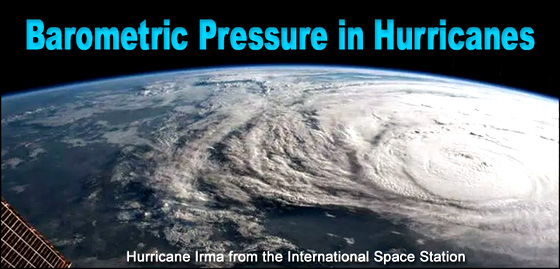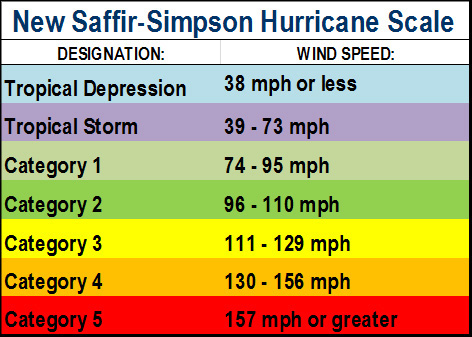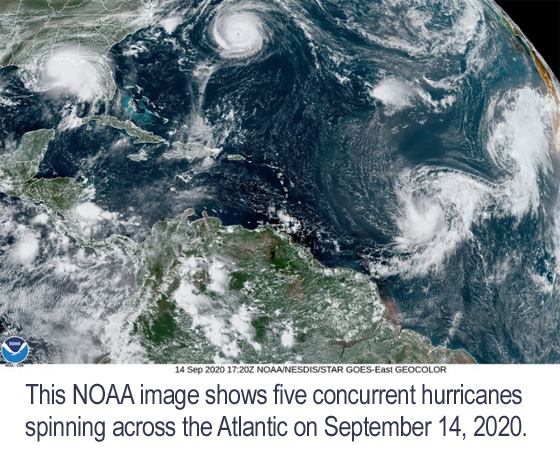How Barometric Pressure Affects a Hurricane’s Strength
 Did you ever notice how closely meteorologists and hurricane forecasters watch hurricane pressure in a storm?
Did you ever notice how closely meteorologists and hurricane forecasters watch hurricane pressure in a storm?
There is a very good reason for their concern: the lower the barometric pressure, the more intense the storm.
We armchair weather watchers tend to focus on the category designation of a cyclone or the highest wind speed. However, weather professionals know the hurricane pressure scale indicates whether a hurricane is weakening or strengthening.
What Is Barometric Pressure?
We generally think of air as being weightless. That is not true. The gases that make up our atmosphere do have weight, since the Earth’s gravity pulls at the atmosphere.
 When acrobats climb in higher and higher tiers, the man at the bottom of the formation feels greater and greater weight. So it is with air. The outer atmosphere places pressure on the gas molecules closest to the Earth, compressing the air at the bottom with its bulk. Air’s gas molecules are squished closer together, making the air denser and heavier.
When acrobats climb in higher and higher tiers, the man at the bottom of the formation feels greater and greater weight. So it is with air. The outer atmosphere places pressure on the gas molecules closest to the Earth, compressing the air at the bottom with its bulk. Air’s gas molecules are squished closer together, making the air denser and heavier.
Air pressure, also called barometric pressure, indicates how the weight of the atmosphere above is shifting.
A falling air pressure generally means there is an approaching storm that will arrive within the next 12 to 24 hours. The farther the barometric pressure drops, the stronger the storm.
Air pressure is measured with a barometer.
The barometer units of measure are called millibars, meaning the atmospheric force exerted on one square meter of surface.
As terrain rises above sea level, the barometric pressure also rises as the air’s gas molecules become less dense.
Scientists consider 1013.2 millibars to be the normal air pressure at sea level on a calm day.
Barometric Hurricane Pressure
Meteorologists gauge not only the intensity but also the cycling of a tropical event by the drops or rises in air pressure and wind speeds.
If barometric pressure increases, the cyclone may be losing strength—or going through a cycle of reorganizing.
Alternately, if the pressure goes down, the storm is intensifying, gaining in strength and in wind speed.
Therefore, the lower the barometric pressure in hurricanes, the higher the wind speeds— and the more dangerous the storm.
Lowest Hurricane Pressures
Here are the lowest pressures of a few of the more infamous hurricanes:
- In 2005, Hurricane WILMA reached the lowest barometric pressure ever recorded in an Atlantic Basin hurricane: 882 millibars.
- In 1988, Hurricane GILBERT reached one of the lowest hurricane pressures at 888 millibars.
- In 1935, scientists recorded a low-pressure reading of 892 millibars in the LABOR DAY Hurricane.
- Hurricane ALLEN clobbered Texas in 1980, after plummeting to 899 millibars.
- In 2005, Hurricane RITA, which inflicted major damage in Texas, sank to 895 millibars at its lowest point.
- Also in 2005, Hurricane KATRINA wreaked havoc on New Orleans and the Gulf Coast, reaching a barometric hurricane pressure chart reading of 902 millibars. When KATRINA made her second landfall, she still registered as low as 920 millibars.
- Hurricane CAMILLE also reached one of the lowest hurricane pressures of 900 millibars in 1969.
- In 1992, Hurricane ANDREW decimated Florida, making landfall as a Category 5 storm. The lowest pressure reading of the monster storm fell to 922 millibars.
- South Texas is still in the cleanup stages after Hurricane HARVEY smashed into the Lone Star state at 938 millibars of pressure.
- Another shock on the hurricane pressure scale was Hurricane IRMA’s barometric reading of 914 millibars, with sustained winds of 185 MPH, with gusts up to 225 MPH.
- In 2012, Hurricane SANDY, dubbed a “superstorm” because of its massive size, recorded a minimum barometric pressure of 940 millibars.
Categories of a Hurricane
 So what are the categories of a hurricane?
So what are the categories of a hurricane?
Meteorologists give hurricanes category designations based on their sustained wind speeds.
Experts do not consider the hurricane pressure scale in labeling the storm’s category. However, the lowest hurricane pressure does directly affect the force of the storm.
As we stated earlier, the lower the storm’s barometric pressure falls, the higher the wind speeds. Consequently, the stronger and more dangerous the storm becomes.
The hurricane category chart provided here indicates the sustained winds speeds that govern the categories of a hurricane in the Atlantic.
Weathering Future Storms
 Unfortunately, NOAA is predicting another active hurricane season for 2021.
Unfortunately, NOAA is predicting another active hurricane season for 2021.
In fact, current research released by NOAA indicates we can expect the following increases in future hurricane activity:
- Increased sea level rises, resulting in higher coastal flooding during hurricanes
- Higher hurricane rainfall amounts, causing increased flooding concerns
- Greater hurricane intensity, fueled by rising global temperatures
- More catastrophic Category 4 and 5 storms than in the past
Building Stronger Structures to Combat Stronger Storms
Clearly, the devastating effects of recent hurricanes demand stronger building codes and stronger structures.
RHINO Steel Building Systems stands ready to meet that challenge.
Our commercial-grade steel buildings are the strongest, safest, smartest way to build. In fact, RHINO’s pre-engineered metal framing is guaranteed to meet or exceed all current local building codes for the lifetime of the structure!
For more information about RHINO-tough steel building products, call our hotline today at 940.383.9566.
(Updated 6-2-2021. Originally published 9-8-2017.)
